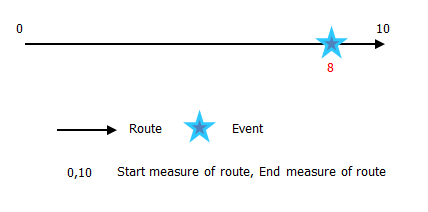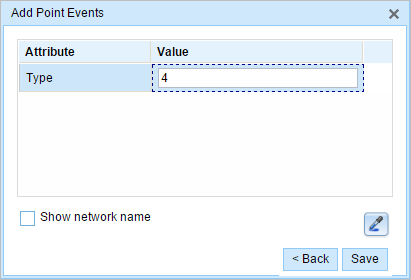Disponible con licencia de Location Referencing.
Route and measure
In this method, the measure is located on the basis of the measure values from the selected route. As shown in the example below, the start measure and the end measure of the route are 0 and 10, respectively. An event with a measure 8 can be located on the route. The route and measure method is always the first option (in the form of the network's name) in the Method drop-down list.
- Open Event Editor and, if prompted, sign in to your ArcGIS organization.
- Click the Edit tab.
- In the Edit Events group, click the Point Events button
 .
.The Add Point Events widget appears.

If there are no editable point event layers, the widget is unavailable.
- Click the Event Layer drop-down arrow and choose an event layer to edit.
- Click the Network drop-down arrow and choose the network that will serve as a source for providing the measure for the new event.
- The widget accepts an LRS Network as a source to identify the location for adding the new point event. However, when the new point event data is being stored in the database, the app performs an internal translation of measures to always store the measure value in the linear referencing method (LRM) of the LRS Network with which the event is registered.
- The Network value can be a published LRS Network layer.
- Provide a route name on which the new event measure will be based using any of the following options:
- Provide a route name in the Route Name text box.
- Click the Select a Route on the Map tool
 and select the route from the map.
and select the route from the map.
The selected route is highlighted on the map.
- In the Location section, click the Method drop-down arrow and choose the first
option (with the suffix Network).

- Provide the location for the new point event along the route using any of these options.
- Type the value in the Measure text box.
- Click the Select From Measure on the Map tool
 and choose the From Measure value along the route on the map.
and choose the From Measure value along the route on the map.
A red cross appears at the selected location on the map.
Nota:
- The new event will be associated with the route (route name) from the LRS Network that the event location intersects. In cases where the input location intersection has more than one route in the registered LRS Network (overlapping routes), a widget prompts you to choose the route from the possible routes.
- If you type the measure value, you can select the unit for that value using the drop-down arrow. The measure value will be converted into the LRS units before saving the newly added events. For example, the LRS is in miles and you have entered 528 feet as the measure value. The newly added events will have a measure value of 0.1 miles because 528 feet equals 0.1 miles.
- Choose the date that will define the start date of the events by doing one of the following:
- Provide the start date in the Start Date text box.
- Click the Start Date drop-down arrow and choose the start date.
- Check the Use route start date check box.
The start date default value is the current date, but you can choose a different date using the date picker.
Nota:
If you configured the Event Editor instance to not allow dates before the start date of the route, and you provide a date that is before the start date of the selected route in Start Date, a warning message appears alerting you to choose a date on or after the start date of the selected route.
- Choose the date that will define the end date of the events by doing one of the following:
- Provide the end date in the End Date text box.
- Click the End Date drop-down arrow and choose the end date.
- Check the Use route end date check box.
The end date is optional, and if it is not provided, the event remains valid now and into the future.
- Notice that the Prevent measures not on route check box is checked by default.
Prevent measures not on route—This data validation option ensures that the input measure values for the start and end measures fall in the minimum and maximum range of measure values on the selected route.
- Click Next to view the Attribute-Value table. This table contains all the attributes of the event layer.

- Fill out all the attribute information for the new event in this table.
Sugerencia:
You can click Copy Attribute Values
 and click an existing point event belonging to the same event layer on the map to copy event attributes from that point.
and click an existing point event belonging to the same event layer on the map to copy event attributes from that point. - Check the Show network name check box to see with which LRS Network the selected event layer is associated.
- Click Save.
A confirmation message appears at the lower right once the newly added point event is saved. The new point is created and appears on the map.
After a point event has been created, you can do the following to continue characterizing the route:
- Click New Edit to clear all the input entries in the widget and restore the default values from the geodatabase to the table.
- Click Next Edit to retain all the existing entries in the widget and the attribute set for convenience and for quick editing of similar characteristics.